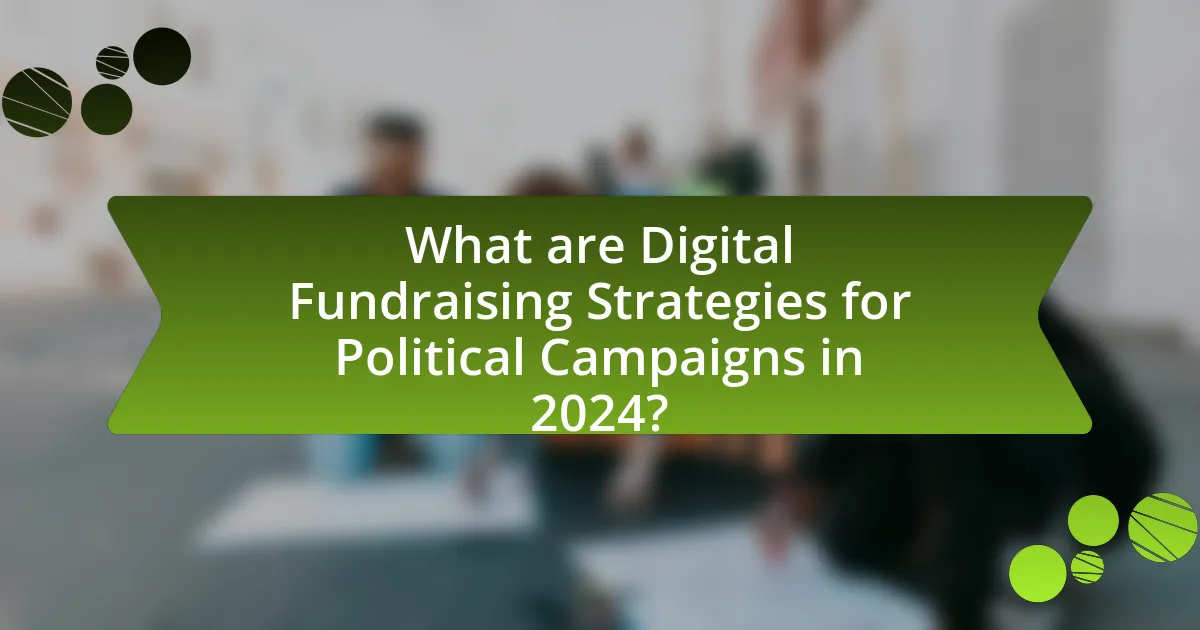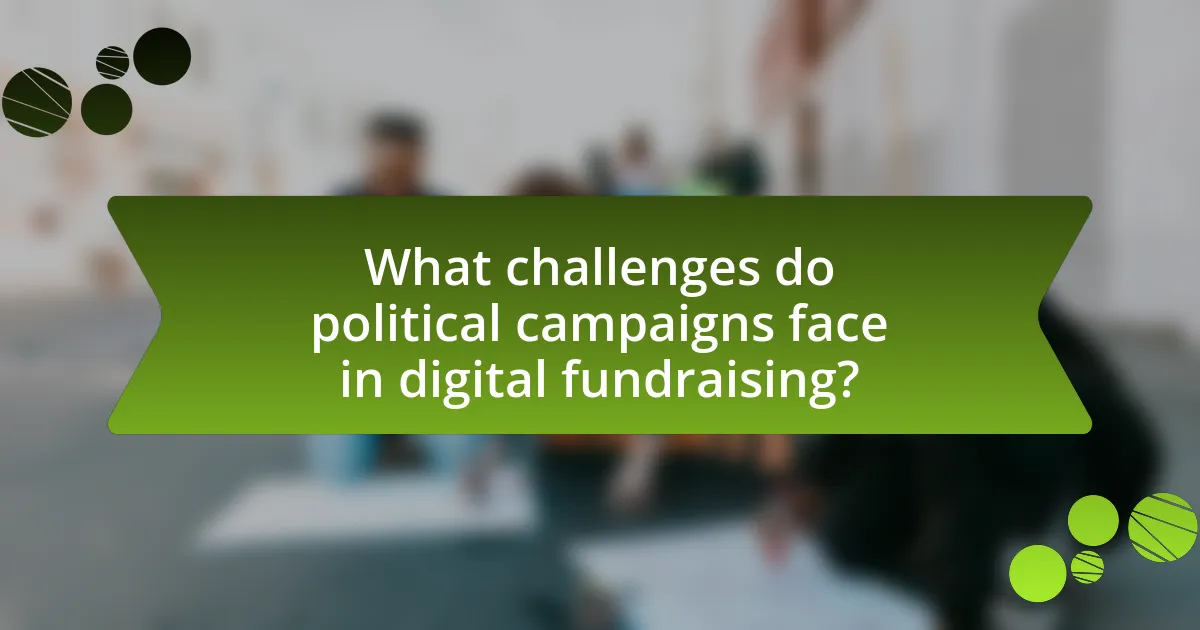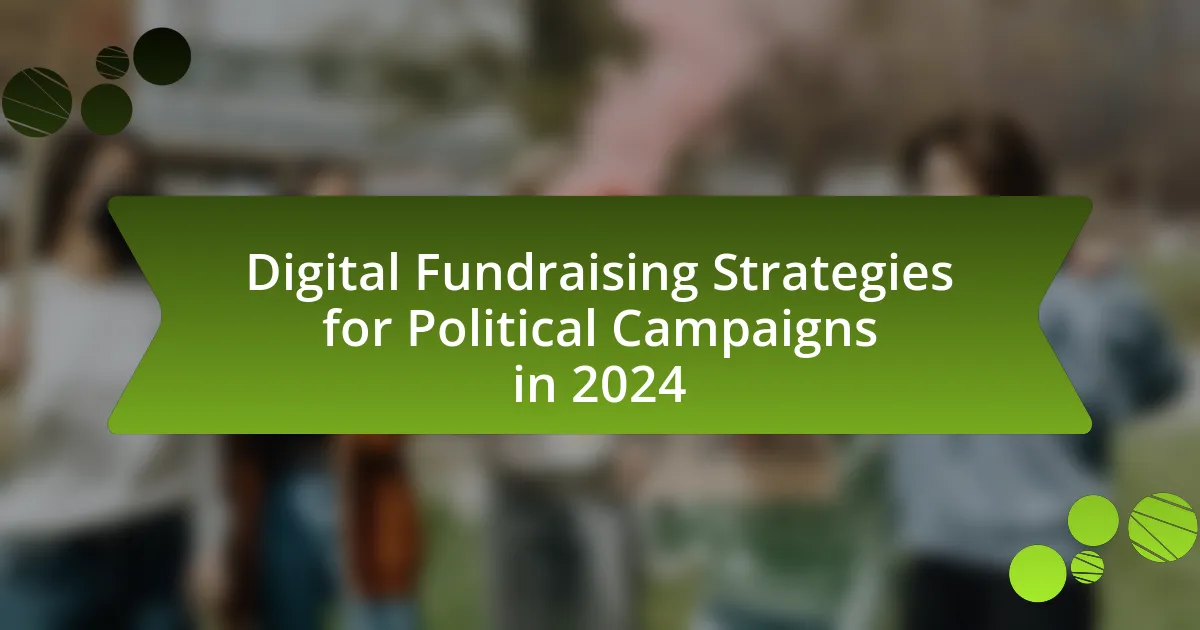Digital fundraising strategies for political campaigns in 2024 are essential for maximizing contributions and mobilizing grassroots support. Key strategies include leveraging social media platforms, utilizing email marketing, and implementing peer-to-peer fundraising, which allow campaigns to reach targeted demographics effectively. The article explores how these digital methods differ from traditional fundraising, the impact of technological advancements, and the significance of demographic shifts. Additionally, it addresses challenges campaigns face, such as donor fatigue and regulatory compliance, while providing best practices for optimizing fundraising efforts through compelling storytelling and data-driven decision-making.

What are Digital Fundraising Strategies for Political Campaigns in 2024?
Digital fundraising strategies for political campaigns in 2024 include leveraging social media platforms, utilizing email marketing, and implementing peer-to-peer fundraising. Social media platforms like Facebook and Instagram allow campaigns to reach targeted demographics effectively, with 69% of adults in the U.S. using these platforms, according to the Pew Research Center. Email marketing remains a powerful tool, with a return on investment of $42 for every dollar spent, as reported by the Data and Marketing Association. Peer-to-peer fundraising encourages supporters to create their own fundraising pages, expanding the campaign’s reach and engagement. These strategies are essential for maximizing contributions and mobilizing grassroots support in the upcoming election cycle.
How do these strategies differ from traditional fundraising methods?
Digital fundraising strategies for political campaigns in 2024 differ from traditional fundraising methods primarily through their reliance on technology and data analytics. Traditional fundraising often involves in-person events and direct mail campaigns, whereas digital strategies utilize online platforms, social media, and email marketing to reach a broader audience quickly and efficiently. For instance, a study by the Pew Research Center indicates that 69% of Americans use social media, providing campaigns with a vast pool of potential donors that traditional methods cannot access as effectively. Additionally, digital fundraising allows for real-time tracking of donations and engagement metrics, enabling campaigns to adjust their strategies dynamically based on immediate feedback, which is not possible with traditional methods.
What technological advancements are influencing these strategies?
Technological advancements influencing digital fundraising strategies for political campaigns in 2024 include artificial intelligence, blockchain technology, and data analytics. Artificial intelligence enhances targeting and personalization of campaign messages, allowing for more effective engagement with potential donors. Blockchain technology provides transparency and security in transactions, fostering trust among contributors. Data analytics enables campaigns to analyze donor behavior and preferences, optimizing fundraising efforts. For instance, a study by the Pew Research Center indicates that campaigns utilizing data-driven strategies can increase donor engagement by up to 30%.
How do demographic shifts impact fundraising approaches?
Demographic shifts significantly impact fundraising approaches by altering the target audience’s preferences and engagement methods. For instance, as younger generations, such as Millennials and Gen Z, become a larger portion of the electorate, political campaigns must adapt by utilizing digital platforms and social media for outreach, as these demographics are more likely to engage online. According to a 2020 Pew Research study, 90% of adults aged 18-29 use social media, highlighting the necessity for campaigns to focus their fundraising efforts on these channels to effectively reach and mobilize younger voters. Additionally, changes in racial and ethnic demographics can influence messaging and outreach strategies, requiring campaigns to tailor their fundraising appeals to resonate with diverse communities. This adaptability is crucial for maximizing fundraising success in an evolving political landscape.
Why is digital fundraising crucial for political campaigns in 2024?
Digital fundraising is crucial for political campaigns in 2024 because it enables candidates to reach a broader audience quickly and cost-effectively. In the current political landscape, where traditional fundraising methods are becoming less effective, digital platforms allow for real-time engagement and mobilization of supporters. For instance, a report from the Pew Research Center indicates that over 80% of Americans use the internet, making it an essential tool for outreach. Additionally, campaigns that effectively utilize digital fundraising can tap into micro-donations, which have been shown to significantly increase overall contributions. In the 2020 election cycle, candidates who prioritized digital fundraising saw substantial increases in their fundraising totals, demonstrating its effectiveness and necessity in modern political strategy.
What role does social media play in digital fundraising?
Social media plays a crucial role in digital fundraising by providing platforms for campaigns to engage with potential donors, share their messages, and mobilize support. Through targeted advertising and organic outreach, political campaigns can reach specific demographics, increasing the likelihood of contributions. For instance, a study by the Pew Research Center found that 69% of adults in the U.S. use social media, making it an effective channel for reaching a broad audience. Additionally, social media facilitates real-time interaction, allowing campaigns to respond to donor inquiries and build relationships, which can lead to increased fundraising success.
How does online engagement affect donor relationships?
Online engagement significantly enhances donor relationships by fostering communication and building trust. When organizations actively engage with donors through social media, email updates, and interactive content, they create a sense of community and belonging. This engagement leads to increased donor retention rates; for instance, studies show that organizations with strong online engagement strategies can see donor retention rates rise by up to 50%. Furthermore, personalized communication through online platforms allows organizations to tailor their messaging, making donors feel valued and appreciated, which is crucial for long-term relationships.

What are the key components of successful digital fundraising strategies?
Successful digital fundraising strategies include a clear value proposition, targeted audience segmentation, compelling storytelling, effective use of social media, and data-driven decision-making. A clear value proposition communicates the unique benefits of donating, while targeted audience segmentation ensures that messages reach the right individuals, increasing engagement and conversion rates. Compelling storytelling connects emotionally with potential donors, making them more likely to contribute. Effective use of social media platforms amplifies outreach and fosters community engagement, as evidenced by the 2020 U.S. presidential campaigns that utilized platforms like Facebook and Twitter to raise significant funds. Lastly, data-driven decision-making allows campaigns to analyze donor behavior and optimize strategies, leading to improved fundraising outcomes.
How can campaigns effectively utilize social media platforms?
Campaigns can effectively utilize social media platforms by creating targeted content that engages specific demographics. By leveraging data analytics, campaigns can identify their audience’s preferences and tailor messages accordingly, increasing the likelihood of interaction and support. For instance, a study by the Pew Research Center found that 69% of adults in the U.S. use Facebook, making it a crucial platform for reaching a broad audience. Additionally, campaigns can utilize features like live streaming and stories to foster real-time engagement, which has been shown to enhance voter connection and mobilization efforts.
What types of content resonate most with potential donors?
Emotional storytelling resonates most with potential donors. This type of content effectively connects with individuals by highlighting personal stories and experiences that evoke empathy and inspire action. Research indicates that campaigns utilizing emotional narratives can increase donor engagement and contributions significantly, with studies showing that emotionally charged appeals can lead to a 20% higher likelihood of donation compared to fact-based appeals. Additionally, visual content, such as videos and infographics, enhances storytelling by making it more relatable and shareable, further amplifying its impact on potential donors.
How can campaigns measure the effectiveness of their social media efforts?
Campaigns can measure the effectiveness of their social media efforts through key performance indicators (KPIs) such as engagement rates, conversion rates, and reach. Engagement rates, which include likes, shares, and comments, indicate how well the content resonates with the audience. Conversion rates track the percentage of users who take a desired action, such as donating or signing up for a newsletter, directly linked to social media campaigns. Reach measures the total number of unique users who see the content, providing insight into the campaign’s visibility. According to a 2022 report by Hootsuite, campaigns that actively monitor these metrics can optimize their strategies, leading to a 30% increase in fundraising effectiveness.
What role does email marketing play in digital fundraising?
Email marketing plays a crucial role in digital fundraising by enabling political campaigns to directly engage with supporters, solicit donations, and build a loyal donor base. This method allows campaigns to communicate personalized messages, share updates, and create a sense of urgency around fundraising goals. According to a 2021 report by the Pew Research Center, 79% of adults in the U.S. use email, making it a highly effective channel for reaching potential donors. Furthermore, campaigns that utilize segmented email lists can increase their fundraising effectiveness, as targeted messages lead to higher open and click-through rates, ultimately resulting in increased donations.
How can campaigns optimize their email outreach for better results?
Campaigns can optimize their email outreach for better results by segmenting their audience and personalizing content. Segmentation allows campaigns to tailor messages to specific groups based on demographics, interests, or past engagement, which can increase open rates by up to 14% and click-through rates by 10% according to Mailchimp data. Personalization, such as using the recipient’s name and relevant topics, enhances engagement, leading to higher conversion rates. Additionally, A/B testing subject lines and content can identify what resonates best with the audience, further improving outreach effectiveness.
What are the best practices for crafting compelling fundraising emails?
The best practices for crafting compelling fundraising emails include personalizing the message, creating a strong subject line, and including a clear call to action. Personalization increases engagement; studies show that personalized emails can lead to a 29% higher open rate. A strong subject line captures attention and encourages recipients to open the email, with effective subject lines often being concise and emotionally resonant. Including a clear call to action directs the reader on what to do next, which is crucial for conversion; emails with a single, clear call to action can increase click-through rates by up to 371%. Additionally, using storytelling to connect emotionally with the audience can enhance the effectiveness of the email, as narratives can evoke empathy and motivate action.

What challenges do political campaigns face in digital fundraising?
Political campaigns face several challenges in digital fundraising, including donor fatigue, regulatory compliance, and competition for attention. Donor fatigue occurs when potential contributors become overwhelmed by frequent requests for donations, leading to decreased engagement and contributions. Regulatory compliance is crucial, as campaigns must navigate complex laws regarding online fundraising, which can vary by state and federal guidelines. Additionally, competition for attention is fierce, with numerous campaigns vying for the same pool of donors, making it difficult to stand out and effectively communicate the campaign’s message. These challenges can hinder the overall effectiveness of digital fundraising efforts.
How can campaigns address issues of data privacy and security?
Campaigns can address issues of data privacy and security by implementing robust data protection measures and adhering to legal regulations. This includes utilizing encryption for sensitive data, ensuring secure data storage, and conducting regular security audits to identify vulnerabilities. According to the General Data Protection Regulation (GDPR), organizations must obtain explicit consent from individuals before collecting their data, which reinforces the importance of transparency in data handling practices. Additionally, campaigns should educate their staff and volunteers on data privacy protocols to minimize human error, which is a common cause of data breaches. By prioritizing these strategies, campaigns can build trust with their supporters while safeguarding their personal information.
What regulations must campaigns comply with in digital fundraising?
Campaigns must comply with federal and state regulations regarding digital fundraising, including the Federal Election Commission (FEC) rules, which mandate transparency in contributions and expenditures. Specifically, campaigns are required to disclose the identities of donors who contribute over a certain threshold, typically $200, and must report all contributions and expenditures in a timely manner. Additionally, campaigns must adhere to laws regarding the use of digital platforms for fundraising, ensuring that they do not accept contributions from prohibited sources, such as foreign entities. Compliance with these regulations is essential to maintain the integrity of the electoral process and avoid legal penalties.
How can campaigns build trust with potential donors online?
Campaigns can build trust with potential donors online by ensuring transparency in their fundraising efforts. Transparency involves clearly communicating how donations will be used, providing regular updates on campaign progress, and sharing financial reports. According to a 2021 study by the Nonprofit Research Collaborative, 70% of donors are more likely to give when they feel informed about the impact of their contributions. Additionally, showcasing endorsements from credible figures and utilizing secure payment methods further enhances trust. These strategies collectively foster a sense of reliability and accountability, which are crucial for encouraging donor engagement.
What strategies can campaigns implement to overcome fundraising challenges?
Campaigns can implement targeted digital outreach strategies to overcome fundraising challenges. By utilizing social media platforms, campaigns can engage with potential donors through tailored messaging and interactive content, which has been shown to increase donor participation. For instance, a study by the Pew Research Center indicates that 69% of adults in the U.S. use social media, making it a vital channel for reaching a broad audience. Additionally, campaigns can leverage data analytics to identify and segment their donor base, allowing for personalized communication that resonates with specific groups. This approach has proven effective, as campaigns that personalize their outreach see a 20% increase in donation rates, according to a report by the Digital Marketing Association. Furthermore, implementing online fundraising events, such as virtual town halls or webinars, can create a sense of community and urgency, encouraging donations. These strategies collectively enhance engagement and drive fundraising success in a competitive digital landscape.
How can campaigns leverage partnerships to enhance fundraising efforts?
Campaigns can leverage partnerships to enhance fundraising efforts by collaborating with organizations that share similar values and goals, thereby expanding their reach and resources. For instance, partnerships with local businesses can provide financial support and in-kind donations, while also increasing visibility through co-branded events or promotions. Research indicates that campaigns that engage in strategic partnerships can increase their donor base by up to 30%, as these collaborations often tap into new networks and audiences. Additionally, leveraging the credibility and influence of established partners can enhance trust and encourage contributions from potential donors who may be hesitant to support a campaign independently.
What innovative tools can assist in streamlining the fundraising process?
Innovative tools that can assist in streamlining the fundraising process include online donation platforms, social media fundraising tools, and customer relationship management (CRM) software. Online donation platforms like ActBlue and Donorbox facilitate quick and secure transactions, allowing campaigns to collect funds efficiently. Social media fundraising tools, such as Facebook Fundraisers, enable campaigns to reach wider audiences and engage supporters directly through their networks. CRM software, like NationBuilder, helps manage donor relationships and track contributions, enhancing communication and targeting efforts. These tools collectively improve the efficiency and effectiveness of fundraising efforts in political campaigns.
What are the best practices for maximizing digital fundraising success?
To maximize digital fundraising success, political campaigns should focus on targeted audience engagement, compelling storytelling, and data-driven strategies. Targeted audience engagement involves identifying and reaching specific demographics through social media platforms and email marketing, which can increase conversion rates. Compelling storytelling creates an emotional connection with potential donors, making them more likely to contribute; campaigns that effectively share personal stories or impactful messages have been shown to raise more funds. Data-driven strategies, such as analyzing donor behavior and optimizing campaigns based on performance metrics, allow campaigns to refine their approaches and improve fundraising outcomes. For instance, according to a 2021 report by the Pew Research Center, campaigns that utilized personalized outreach saw a 20% increase in donor retention compared to those that did not.
How can campaigns create a compelling narrative to engage donors?
Campaigns can create a compelling narrative to engage donors by focusing on authentic storytelling that highlights the impact of contributions. This approach involves sharing personal stories of individuals or communities positively affected by the campaign’s mission, thereby fostering an emotional connection with potential donors. Research indicates that narratives that evoke empathy and illustrate tangible outcomes can significantly increase donor engagement and willingness to contribute. For instance, a study by the Stanford Social Innovation Review found that storytelling can enhance donor motivation by up to 50%, demonstrating the effectiveness of this strategy in fundraising efforts.
What metrics should campaigns track to evaluate fundraising performance?
Campaigns should track metrics such as total funds raised, donor retention rate, average donation size, and cost per dollar raised to evaluate fundraising performance. Total funds raised provides a clear measure of financial success, while donor retention rate indicates the effectiveness of engagement strategies, with studies showing that retaining existing donors is more cost-effective than acquiring new ones. Average donation size helps assess the impact of different fundraising strategies, and cost per dollar raised measures the efficiency of fundraising efforts, allowing campaigns to optimize their budget allocation. These metrics collectively offer a comprehensive view of fundraising effectiveness and areas for improvement.



